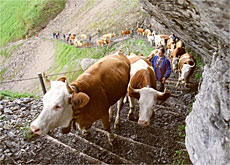Globalisation threatens alpine rite

With the snow finally melted, cattle have returned in colourful processions to the alpine meadows where they will graze for the summer.
The “alpine procession” is an age-old rite little altered over the centuries, but it presents a false idyll of a type of farming that is undergoing radical change.
Accompanied by tourists and journalists, herdsmen last Saturday led about 350 cows in single file up a path hewn out of the steep cliff leading to the pastures on Engstligenalp, outside the resort of Adelboden (see video).
The herd had to climb 600 metres in altitude in what is arguably the most spectacular ascent of its kind in the Swiss Alps.
Many camera-toting visitors were able to forego the arduous journey by paying for a cable car ride to the top, where they were welcomed with a “mountain breakfast”.
Cattle processions like this take place across the Swiss Alps in June and early July, and are key events in the calendar of Switzerland’s tourist industry since they cement the country’s pastoral image.
Traditional landscape
Visitors to the countryside still find a traditional landscape blending forests, pasture and cultivated meadows dotted with farmhouses.
And the farm holdings are still small (about 15 hectares and 20 milk cows per farmer), with cheese still made in small batches on the premises.
Yet this is where the idyll ends.
The village cooperatives, which often own the alpine pastures, have for years been faced with a dearth of skilled herdsmen and cheesemakers.
It is estimated that half of all farmhands hired by the cooperatives have no previous experience in agriculture. Many have grown up in Swiss or German cities and are simply seeking an alternative way to spend the summer.
Subsidy cuts
And cuts to agricultural subsidies as Switzerland is integrated into the European market pose another, more real threat to this traditional way of farming.
A study done in 2002 by the Federal Institute of Technology in Zurich found that economic pressures could alter the face of the alpine landscape over the next ten to 15 years.
According to the study, farmers will have to give up milk production and start rearing cattle for meat, which is less labour intensive and brings higher returns.
This development would lead to larger but fewer farms, with consequences for the environment: beef cattle need more pasture to graze, limiting the amount of meadow set aside for cutting hay.
The study concludes that this would therefore lead to less biodiversity, greater soil erosion and a landscape which is less attractive to tourists.
swissinfo, Dale Bechtel
Swiss farmers have to adapt to new conditions brought about by globalisation.
A Swiss-EU accord calls for an end to customs tariffs and export subsidies over the next three years.
This is expected to put pressure on the price of milk in Switzerland.
Direct farming subsidies still amount to SFr3.5 billion ($2.8 billion) a year.

In compliance with the JTI standards
More: SWI swissinfo.ch certified by the Journalism Trust Initiative











You can find an overview of ongoing debates with our journalists here . Please join us!
If you want to start a conversation about a topic raised in this article or want to report factual errors, email us at english@swissinfo.ch.